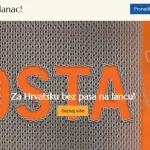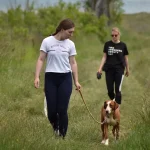As Glas Istre/Andjelo Dagostin writes on the 20th of January, 2020, on a sunny winter afternoon, Glas Istre reporters arrived at Pazin Animal Shelter, housed in two buildings of an old military complex located just north of Pazin, at a location called Loke near Pazinčica.
They were welcomed by the Pazin Animal Shelter’s manager, Pazin local Mae Isaksson, who, together with her daughter, Maja Lilith Klemen (president of the Happy End association) and volunteer, Swede Benny Andersson, has been caring for abandoned animals, primarily dogs and cats, for over a decade now. On weekends, 20-30 volunteers come from all over Istria to lend a helping hand at the Pazin Animal Shelter, and in the summer months, even tourists show up. Some come and work, but most walk the dogs.
When they decided to open an animal shelter back in the spring of 2010, they looked for terrains and facilities around Pazin that would be suitable for this, however, Pazin itself had very little to offer. They decided to equip a part of an old military complex that was empty, devastated and that had been of no interest to anyone for some twenty years. Pazin requested that the Ministry of Defense hand over these non-prospective facilities for ownership, concession or lease. In the meantime, the asylum-plots were included in their spatial plans for the purpose of the animal shelter, and some time has been lost on the property-legal solution of a disputed piece of land, a classic Croatian saga. Nevertheless, a shelter project for fifty dogs was completed and a location permit was issued for it.
”Ten years have now passed and we haven’t gotten anywhere,” says Isakkson, and when asked where the plot is, he says that the asylum-containing plots of land are currently owned by the State Property Ministry, which now has no obstacles in its way to solve the problem. He notes that they have encountered a legal problem, however. Specifically, the first few metres of the plot on which the main shelter building is located was affected by the flood risk zone and it should therefore not be located in such an area. Owing to that, Pazin applied for an asylum permit for an adjacent plot of land that is not in any area within the risk zone.
”But what happened at the end of last year? A new law on shelters was released that deleted the item on flood risk zones, so that what has been the biggest obstacle for us to legalise the facility has now been resolved. It would be expensive for us to go and build a brand new shelter,” Isaksson says, adding that after Pazin’s involvement with the water and rubbish collection, they needed more electricity, a septic tank and renovation of facilities as well as the installation of more adequate heating, etc.
For the time being, solar panels are being used for light, as some dogs must be treated with their various therapies at night.
“We’re now waiting for the opinion of the County Office for Spatial Planning as to whether or not there is any other legal obstacle preventing us from registering the Pazin Animal Shelter. But now it’s certain that the asylum will come to be: either it will be registered or a new one will be built on the adjacent parcel of land,” Isaksson explained.
Legalising the business would ultimately provide them with finances (food, veterinary care and employee benefits), as they now depend on a donation from Pazin and on people’s goodwill.
When it comes to the question of how many animals have been adopted so far, Isaksson responded:
”Considering all those who only stayed with us for a few days or were temporarily staying with someone, we must have adopted over a thousand dogs by now. Until last year, on average, we received and fostered about a hundred dogs a year, but then you’re there from morning till dark, there is no moving anywhere. Last year, we significantly reduced the number of dogs we took in because of our uncertain future,” said Isaksson, adding that cats are rehomed much less frequently.
They currently care for 40 dogs and 60 cats, but they also have pigeons, ducks and even one young seagull. A real little zoo. How did the young seagull come to the Pazin Animal Shelter?
”They brought him from Pula for us to rehabilitate him and then let him go. We planned on having him with us for a week or two until his injured leg was healed. And now he’s completely healed, but he can’t fly even though his wing looks normal and the x-ray shows nothing, apparently some nerve is destroyed. Maja tried to put him back by the sea anyway, but the bird did not want to go. One can see that he knows what to do, run, take off, but one wing doesn’t work at all and now he lives here. He gets along with the ducks very well,” Isaksson noted.
In the enclosure, five ducks and one seagull swim around in small pools. Very nice. How did the ducks get there?
”I bought them at the cattle fair in Zminj, because I felt sorry for them. The seller said that these little ducks would weigh three pounds in three months and would be ready for slaughter. And so, for two years now, which is already old age for fattening ducks in our country, here they are,” said Mae.
Although this is not the focus of their activities, Glas Istre journalists asked whether they were engaged in animal rights initiatives or improvements to farm conditions.
”Whenever we have the opportunity and time, even though we have no space here, but we certainly support and join any such petition or action,” Mae replies. She added that when they started the Pazin Animal Shelter, the ideas were much larger and more complex – an animal centre with special departments for dogs, cats, a wildlife rehabilitation centre, and a farm animal shelter where children could be shown how animals should live, etc.
We don’t advocate veganism so much, people should be left to choose whether they want to eat meat or not, but we advocate for the proper conditions of domestic animals while they’re alive,” points out Mae, who says they had big plans, but after ten years they are already a little tired and have lost hope that some of it will ever come to be.
This does not mean that they do not have wild animals visit within the vicinity of the Pazin Animal Shelter, because of the proximity of drinking water in the stream, they often see wild pigs, foxes, roe deer, badgers, rabbits, weasels and more.
Make sure to follow our dedicated lifestyle page for more.









